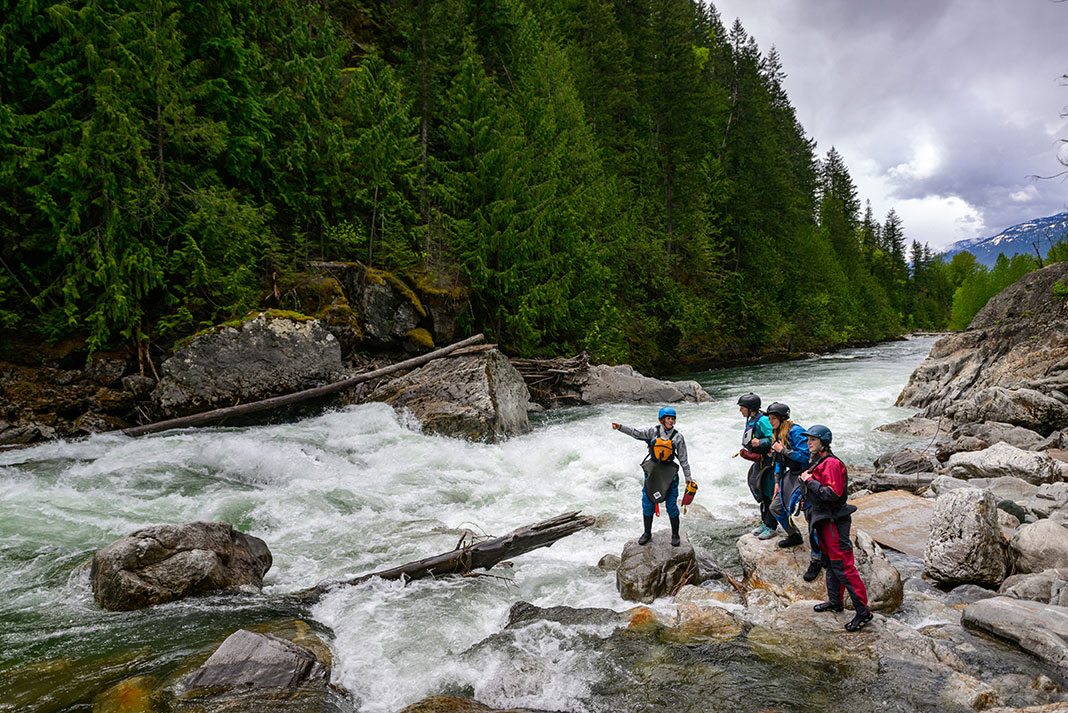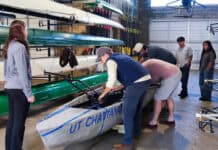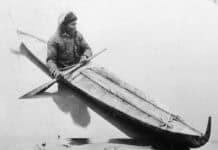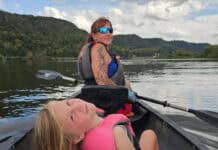In November 2024, Level Six launched the Freya Drysuit Design Feedback Survey, seeking input on measurements, fit and stories from paddlers who have experiences with women’s or non-unisex drysuits.
In all, 480 people filled out the survey, representing a niche population of an already niche sport — women’s drysuit users. According to Morgan Lirette from the Level Six team, the average user spent a half hour filling out the survey and a variety of age groups and skill levels were represented.
Kokatat launched the first women’s paddling drysuit in 1995. Today, every major drysuit manufacturer makes at least one women’s option. After 30 years of innovation and refinement in women’s drysuits, what’s unique about Level Six’s initiative is that they’re collecting user-driven data and hundreds of personal anecdotes about how drysuit fit has affected women as data for future updates to their drysuit line.
“We can’t say we’re creating accessible and inclusive gear unless we’re looking at who our gear actually fits, and does it actually fit and work for our clientele,” shared Lirette.
“Making a drysuit that has a better fit doesn’t necessarily mean that more people are going to buy it… but for people who really are looking for a drysuit that is well thought-out and has fit in mind it is going to be a game changer, more than just owning drysuit that gives you the ability to paddle,” Lirette added.
“Shrink it and pink it” in outdoor sports
Many sports come from a long legacy of “shrink it and pink it”, or the practice of taking products designed for and often by men, scaling those products down in size and making them pink or traditionally “feminine” without actually altering the product design to meet the needs of users. While the outdoor industry has made efforts to better consider the distinct needs of female paddlers, there is still a long way to go when it comes to leveling the playing field.

Anecdotally, the most common gripes women report are that their drysuits fit too tightly in the hips, bust, and thighs. Or, when a drysuit does fit in those places, some report excess fabric length-wise or in height.
But how does one quantify the importance of gear fit beyond the conversations of women and people who don’t fit the unisex drysuit well?
Lirette shared that while measurements were an important part of the Freya Drysuit Design Feedback Survey, it was just as important to get context beyond the measurements. Put simply, what are the effects when a person cannot find outdoor gear that fits them well? What are the stakes of a lack of inclusive sizing?
Why drysuit fit matters in paddling skill development
“A lot of the comments and responses we got were extremely personal, extremely passionate people sharing how this [drysuit fit] has affected them—their mental health, body image, their paddling skills and abilities,” Lirette shared.
Which, of course, makes sense: bodies are personal. A drysuit is an important piece of gear for paddlers looking to advance their skill set and practice rescues. Drysuits keep a paddler dry when in the water and extend the paddling season from summers and warm water exclusively to anywhere and anytime there is open water to paddle.
Too tight, and a drysuit can restrict motion. Too large with excess material, drysuits can snag, get in the way and also restrict motion.
A paddler who can’t find a drysuit that fits them well will not be able to practice effectively in colder water, preventing that paddler’s skills from progressing. This holds true for outdoor gear well beyond the realm of paddling: a hiker who cannot find a backpacking bag that fits their body has an additional barrier to becoming an accomplished backpacker.
Gear fit is a concrete barrier for many people in outdoor sports when it comes to building skills, but it also has more subtle effects that can be even more difficult to quantify. Drysuit fit is personal for paddlers of many skill levels, including Lirette, who, in addition to her role at Level Six, has worked as a whitewater kayaking instructor on the Ottawa River.
“I had a time period where I felt that my growth as a paddler had kind of stagnated,” Lirette shared. “We are so lucky that the Ottawa River is warm water, warm weather paddling in the summer, but anything shoulder season is not… there was a point where I was really struggling to find a drysuit.”
The typical drysuit runs anywhere from $800 USD to $1,500 USD, making it one of the most expensive pieces of paddling gear beyond a boat itself.
“If I’m investing that much in something that isn’t going to fit? I’m not going to be comfortable, that’s what I’m going to be preoccupied with, thinking about when I’m trying to paddle harder stuff,” Lirette added. “I’m not going to do well.”
“It’s a barrier that just shouldn’t exist. For a lot of people, it doesn’t, and they’re fine; they can get a drysuit that works,” said Lirette. “But for the people that it does exist, it’s a huge factor.”
The widespread effects of “shrink it and pink it”
The practice of “shrink it and pink it” makes waves far beyond the outdoor industry, and in its wake impacts range from stymying the growth of female outdoor athletes to more insidious results.
Verity Now shares that women in the United States are 73% more likely to sustain injuries in a vehicle crash than men, and 17-18.5% more likely to die in a vehicle crash than men. Tellingly, female dummies are not required in the United States to be crash tested in the driver position in vehicles.
According to an article in Harvard Social Impact Review, female soldiers in the United States are more likely to fracture their pelvis than males as a result of the unisex design of military boots, backpacks, and course requirements.
Survey results
Lirette shared that information Level Six gathered via the survey will be reflected in changes in the 2027 Freya drysuit line.
“We say it’s a women’s fit survey, but it’s not a problem that affects women exclusively. We’ve kind of used women’s as a term for anyone who doesn’t use male or unisex gear.” Lirette went on to add that the survey is about more than women’s fit, and rather about meeting the needs of a growing sport and changing industry.
This isn’t the first time Level Six has worked to make gear for more body types; their push for inclusive sizing is also reflected in the Ace Sprayskirt, Level Six’s spray skirt designed for big water, which in addition to a variety of tunnel sizes also has a trim-able tunnel length, meaning that paddlers can customize fit at home.
“Fifty percent of our staff is female, all of whom actively paddle. We are constantly getting feedback from our team to make sure we are adjusting the fit and features to meet their needs for a higher-performing garment. With a big push right now as a company to ensure that every piece of gear we make has a female-specific option, we have the unique opportunity to start from scratch on many of these new styles to ensure the fit is perfect,” shared Stig Larsson, CEO of Level Six.
While the Level Six team has already gathered the data they needed for drysuit design updates, they’ve decided to leave the survey up on their website as a place for paddlers who don’t see their body type represented in gear to share their stories.
Find the survey linked here.
Feature Image: Paddler Katie Kowalski in a Level Six Drysuit | Casey Bryant Jones, courtesy Level Six











Shrink It and Pink It: Gender Bias in Product Design (Karen Korellis Reuther)
This was the name of the article that was quoted written in the Harvard Advanced Leadership initiative social impact review.
In fact the title seems rather similar. If this were a college course Ms Maddy Marquardt would be cited for plagiarism.
Please, if a source is going to be used properly site this.
This is an article that was already published!! Not only did Marquardt poach the title of the article she also failed to properly cite the source for the article which was utilized to provide justification for the point.
Most of the points made in this article written in this publication came directly from the Korellis article!
To be frank here I find this to show a lack of integrity!! After, reading the article in the Social impact review I see true valid points being made by the author of that article!
What I see of this article is a person trying to piggy back of not only the title infringement but also the concept.
This would not be such an egregious error had Marquardt done her due diligence and properly cited her source!
My other grievance is with the publication itself for allowing this to occur.
Now with this stated I agree with the statement made in the Harvard Review article.
In this article the statement is that it is hazardous to have improperly fitting safety equipment. This is accurate.
Helmets, PFDs and dry suits are safety equipment. They need to fit properly.
In the same fashion that a soldiers Kevlar and IBA (individual body armor) need to fit properly to function effectively. An ill fitting piece of equipment can cause injury or even death.
Here are the facts women exist and women are working in industries that require them to have proper access to required safety equipment to do their job.
This is not just an issue of having a dress that fits for the prom this can be a life or death situation.
This should not be a suck it up ladies make it work situation. This is a situation where society has welcomed us as women to the playing field. This is not about if or not women belong or who is taking the job from a more qualified male candidate is as always the argument.
This is about safety. Women are there. Women serve as soldiers, firefighters, cops, astronauts, pilots and a host of other jobs to include paddle sport industry related jobs.
I find it to be a travesty that in 2025 women have to still argue for the basic right to exist and have what is required to safely participate in a field.
I also find it an unfortunate that the person who wrote the article for Paddling magazine and its editorial staff could not have done the same justice to this issue as the Harvard Social review has done.
I am not sure why a Harvard Review article written about the higher percentage of female soldiers breaking their pelvis is being quoted as justification for the paddle sport industry’s lack of proper accommodation for women.
The gear is not the only issue. I spent the first half of my paddle sport career paddling in a paddling jacket and wool sweater.
I managed.
The problem is how women are viewed. Why are articles published by women only about how the gear fits or doesn’t fit?
An article about pink gear is what is viewed as women in the sport making a contribution?
Get real!
Good points all! Mass produced products work well for the masses and are designed and constructed around a set of specs that does a good job overall of fitting a wide variety of people. If you have particular characteristics that make a custom fit necessary the you’ll simply have to have the product custom made. No matter what your kindergarten teacher told you, “Life ain’t always fair!”
The shrink it and pink it idea of gear for women died along time ago, at least since the new millennium. Many outdoor gear companies have made gear to fit women for decades. This includes packs with shoulder harnesses and waist belts for women’s anatomy, climbing harnesses with a different rise to fit a different pelvis shape, sleeping bags shaped for women with more hip space and less shoulder room. Nordic ski companies in the 80’s made boots that used a men’s last from size 42 up and a women’s last from 41 down. If some companies haven’t moved to separate gender based designs they may not have recognized the changing demographics of outdoor sport. But problems always arise if you don’t fit a “normal” pattern for gear or clothing. I am 6′ 2′ tall, weigh 170lbs and easily find jeans to fit in 32 waist and 34 inseam.
but finding a tight that fits is hard. My wife is 5′ 11′ and can’t get her shoulders in average women’s sizes. Her shoe size is 10 and 1/2 so there were few women’s shoes that worked 30 years ago. Now boot companies make footwear on a women’s last up to 11US ie 43 and 44 euro.
Your article makes a good point about some gear and clothing, it won’t fit everyone. If you are not average for a s/m/lg/xl size run you may have to get custom fit clothes. A women came to our shop who had feet sized 5 with e width. There are no women’s off the shelf footwear for her. Someone 5 foot 2 weighing 180 won’t buy clothes off the rack. If you are looking for specialized gear and the company you like doesn’t make it in your size, call them to task and/or ask for a custom fit. Then you can get exactly what you need.